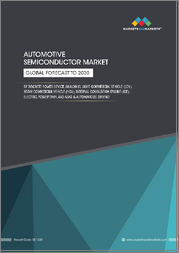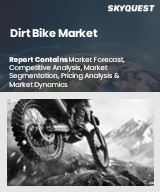
|
시장보고서
상품코드
1453695
세계의 내연기관 시장 : 연료별, 최종 용도별, 지역별, 기회 및 예측(2017-2031년)Internal Combustion Engine Market Assessment, By Fuel [Petrol, Diesel, Others], By End Use [Automotive, Marine, Aviation, Others], Region, Opportunities and Forecast, 2017-2031F |
||||||
세계의 내연기관 시장 규모는 2024년부터 2031년까지 예측기간 동안 6.21%의 연평균 복합 성장률(CAGR)로 확대될 전망이며, 2023년 1억 9,313만 대에서 2031년에는 3억 1,273만 대로 성장할 것으로 예측되고 있습니다. 내연기관은 전자 모터의 출현, 급속히 변화하는 자동차 요구 사항, 환경 규정 준수, 자동차의 전기화로 인해 해마다 진화해 왔습니다. EV의 출현으로 IC 엔진 제조업체는 저 배출 가스 또는 제로 방출을 촉진하는 가스 기반 엔진으로의 전환을 촉구하고 있습니다. 그러나 전기차, 하이브리드차, 연료전지차는 아직 새롭고, 정부의 자금 원조 및 인센티브 등의 속성이 필요하기 때문에 내연기관은 세계의 자동차 산업의 대부분을 차지하고 있습니다.
내연기관의 수명을 연장하는 핵심은 보다 깨끗한 연료를 사용하여 차량의 연료비 및 유지 보수 비용을 줄이고 온실가스 배출량을 줄이는 것입니다. 신형 엔진은 질소 산화물(NOx)과 같은 주요 오염물질에 대한 향후 배출 기준을 쉽게 충족시킬 수 있습니다. 각 회사는 컴플라이언스를 수용할 수 있도록 미래 내연기관을 제조합니다. ICE의 미래에는 덕트 연료 분사의 도입, 대체 연료와의 호환성 등이 포함됩니다.
이 보고서는 세계의 내연기관 시장을 조사했으며, 시장 개요와 함께 연료별, 최종 용도별, 지역별 동향 및 시장 진출기업 프로파일 등의 정보를 제공합니다.
목차
제1장 조사 방법
제2장 프로젝트의 범위 및 정의
제3장 주요 요약
제4장 고객의 목소리
제5장 세계의 내연기관 시장 전망(2017-2031년)
- 시장 규모 및 예측
- 연료별
- 최종 용도별
- 지역별
- 기업별 시장 점유율(%)(2023년)
제6장 세계의 내연기관 시장 전망 : 지역별(2017-2031년)
- 북미
- 유럽
- 아시아태평양
- 남미
- 중동 및 아프리카
제7장 시장 매핑(2023년)
제8장 거시적 환경 및 산업 구조
- 수요 공급 분석
- 수입 수출 분석
- 밸류체인 분석
- PESTEL 분석
- Porter's Five Forces 분석
제9장 시장 역학
제10장 주요 진입 기업의 정세
제11장 사례 연구
제12장 가격 분석
제13장 주요 진입 기업의 전망
- MITSUBISHI HEAVY INDUSTRIES
- MAN SE
- General Motors
- Ford Motor Company
- FCA US LLC
- Robert Bosch GmbH
- AGCO Corporation
- Caterpillar
- Shanghai Diesel Engine Co. Ltd.
- AB Volvo
- TOYOTA MOTOR CORPORATION
- Volkswagen Group
- Rolls-Royce plc
- Mahindra & Mahindra Ltd.
- Renault Group
제14장 전략적 제안
제15장 문의 및 면책사항
AJY 24.04.09Global internal combustion engine market is projected to witness a CAGR of 6.21% during the forecast period 2024-2031, growing from 193.13 million units in 2023 to 312.73 million units in 2031. The internal combustion engine has evolved over the years with the advent of electronic motors, rapidly transformed vehicle requirements, environment compliances, and electrification of vehicles. The advent of EVs has pushed IC engine manufacturers to switch to gas-based engines that promote lower emissions or zero emissions. However, internal combustion engines hold a major part of the global automotive industry as electric, hybrid, and fuel cell vehicles are still new and require attributes such as government funding and incentives.
The key to this extended service life for ICEs is the use of cleaner fuels, that reduce fuel and maintenance costs for fleets and greenhouse gas emissions. The newer engines easily meet upcoming emission standards for key pollutants such as nitrogen oxides (NOx). The companies are building their future engines to be compliance ready. The future of ICEs includes the implementation of ducted fuel injection, compatibility with alternative fuels, and others.
For instance, in June 2023, Cummins Inc. began testing its X15N engine with United States customers. The X15N is the largest natural gas-powered, heavy-duty trucking powertrain in North America. The goal of the testing operation of this sustainable engine is to deliver an experience that is no different from that of a diesel engine.
High Power, Well-Refined, and Technological Advancements to Fuel Market Growth
The demand for IC engines has been on the rise. However, due to the rise of crude oil prices, strict emission standards, fuel supply safety, and noise pollution, OEMs have started to focus on natural gas and hydrogen-based engines. As technology advances, the design of an internal combustion engine evolves. The IC engines deliver more power while consuming less fuel. Engines continue to be an integral part of the automotive industry's development. Companies keep on refining their engines by integrating them with the latest technology. Technologies such as artificial intelligence and machine learning have revolutionized engine design and manufacturing, allowing developers to deliver well-refined engines. These engines include compression ignition gasoline engines such as Mazda Skyactiv-X, turbocharged engines including Infinity VC-T, and others.
For instance, in September 2023, Caterpillar Oil & Gas introduced the latest generation of the industry's most powerful series of engines, the Cat, G3600 Gen 2 Engine. Built on the robust G3600 platform, the Gen 2 engine delivers 10% more power and reduced emissions than the previous generation.
Advent of Hydrogen-based Internal Combustion Engine to Expand Market Size
A major highlight of transitioning engine technology comprises the concept of hydrogen-based ICEs. Many automotive engine vendors have now launched their hydrogen engines with lower emissions, higher efficiency, and a long range of operations. The overall growth of the engine is impacted by the fuel cell technology as it also powers the vehicles through hydrogen. Hydrogen Internal Combustion (ICE) engines are becoming increasingly popular to decarbonize mobility and reach carbon neutrality. Specific development challenges for hydrogen engines include improving combustion, reducing emissions, and improving safety. The advantages of hydrogen ICE include the use of common parts, knowledge, and research facilities of conventional gasoline and diesel engines. Furthermore, hydrogen ICE diverts and uses conventional gasoline and diesel engine parts, maintenance and development, and operating skill sets for internal combustion engines.
For instance, in January 2024, Bosch announced its plan to launch its first hydrogen internal combustion engine for trucks. The launch is going to be a part of its offering of fuel cell and battery-electronic systems. The company is claiming it is equivalent to its diesel engine.
Government Policies and Compliance Policies for Emissions
The automotive fuel transition roadmap is supported by government compliance policies. Authorities focus on limiting the carbon footprint through incentivizing EV, hybrid, and fuel cell technologies. However, the ICE covers a major portion of the existing number of automobiles on the road. Various countries have introduced new emission standards to regulate the automakers.
For instance: In April 2023, the government of India rolled out the second phase of its 6th emission standard named Bharat Standard 6 (BS6-2) which is equivalent to the Euro 6 standard applicable for all vehicles across Europe.
The new automakers are sticking to these compliances and launching their vehicles according to them. Apart from the advanced features, the next-generation internal combustion engines are expected to be more refined, efficient, and sustainable. While several manufacturers have introduced their BS6 2 models, some are yet to make this emission norm transition.
For instance, in January 2023, Hyundai India was one of the first brands to implement RDE norms in India. The company started the roll-out of BS6 2-compliant vehicles with the introduction of the Nios and the Aura. Subsequently, the update was introduced in the SUV segment with the introduction of Creta, Alcazar, and Venue.
Automotive Segment leads the Global Internal Combustion Engine Market
Based on the end-user category, the automotive segment holds a significant share of the market due to the higher consumption, higher sales of ICE vehicles, and increased adoption of commercial vehicles. This growth can be attributed to the increasing consumer disposable income levels that have led to an increase in the number of cars on the roads around the world. As a result, automotive manufacturers focus on the development of high-performing internal combustion engines that provide high returns on manufacturing investments. In addition, technological innovations that improve IC engine fuel efficiency, emissions, and overall performance are expected to drive market growth. The aviation segment also accelerates at a decent rate due to increased connectivity and personal aviation. Apart from passenger vehicles, commercial vehicles such as trucks are also being upgraded with hydrogen-based IC engines.
For instance, in February 2023, Reliance Industries Limited introduced India's First Hydrogen Internal Combustion Engine for heavy-duty trucks. H2ICE-powered trucks would emit close to zero emissions, provide comparable performance to conventional diesel trucks, reduce noise, and reduce operating costs.
Asia-Pacific Leads in the Global Internal Combustion Engine Market
Asia-Pacific region is anticipated the hold the major share of the market due to the increased per capita income that has fuelled the sales of personal and commercial vehicles. However, EV adoption is also on a surge in the region, the ICE vehicles still hold the major market. Emerging economies such as India and China have introduced their latest emission standard for IC engine manufacturers to comply with. The local auto-tech companies are also transforming the engine design to make it more efficient and powerful. In addition, the low charging infrastructure in the region and the high price of electric motors contribute to the market growth. The use of natural gas in the ICE due to the low emissions also aims to make the ICE an alternative to the EV. The sales of ICE vehicles have also increased the sales of imported powerful vehicles.
For instance, in February 2024, Mini announced the global launch of the fourth generation of the Cooper and Cooper S. This marks the end of the sporty ICE-powered 3-door hatchback. Future Cooper models will only be available in fully electric forms. The car is expected to be launched in the 3rd quarter of 2024 in India.
Future Market Scenario (2024-2031F)
Higher sales of passenger and commercial vehicles in Asia-Pacific are anticipated to garner the global internal combustion engine market.
The government compliances with higher adoption of electric, hybrid, and fuel cell vehicles are expected to impact the ICE market.
Companies producing hydrogen-powered ICE along with high-mileage technology shape the market dynamic.
Key Players Landscape and Outlook
The internal combustion engine market comprises major automotive players. It consists of automobile manufacturers along with equipment manufacturers. The companies focus on upgrading the engine technology with the latest emission standards to survive the EV push. The ICE vendors also focus on integrating engine systems to power vehicles that run on alternative or hybrid fuels such as hydrogen ICE. Furthermore, companies adopt expansionist strategies such as collaboration, acquisition, and partnerships. Companies also experiment and launch new products that comply with global automotive standards.
For instance, in December 2023, Renault group introduced its new 1.0-litre GDi Turbo petrol engine with the launch of the Kardian Compact SUV in Brazil. This new engine is flex-fuel compatible and is expected to be sold around the world in several emerging markets as part of Renault's global growth strategy in 2027. The engine produces 125 bhp and 220 Nm of torque. It offers with a 6-speed dual-clutch transmission. This is an upgrade to the 3-cylinder engine offered in India which produces 99 bhp/152 Nm/160 Nm mated to CVT and 5-speed manual.
In February 2022, Toyota and Yamaha developed a hydrogen-fuelled V8 engine. The unit delivers as much as 450 horsepower at 6,800 revolutions per minute. Developed for the automotive market, the 5.0 v8 engine will be based on the engine used in the Toyota Corolla MX5, with changes made to the cylinder heads and the injectors.
Table of Contents
1.Research Methodology
2.Project Scope & Definitions
3.Executive Summary
4.Voice of Customer
- 4.1.Efficiency
- 4.2.Power
- 4.3.Performance
- 4.4.Emission
- 4.5.Torque
5.Global Internal Combustion Engine Market Outlook, 2017-2031F
- 5.1.Market Size & Forecast
- 5.1.1.By Value
- 5.1.2.By Volume
- 5.2.By Fuel
- 5.2.1. Petrol
- 5.2.2. Diesel
- 5.2.3. Others
- 5.3.By End Use
- 5.3.1. Automotive
- 5.3.2. Marine
- 5.3.3. Aviation
- 5.3.4. Others
- 5.4.By Region
- 5.4.1.North America
- 5.4.2.Europe
- 5.4.3.Asia-Pacific
- 5.4.4.South America
- 5.4.5.Middle East and Africa
- 5.5.By Company Market Share (%), 2023
6.Global Internal Combustion Engine Market Outlook, By Region, 2017-2031F
- 6.1.North America*
- 6.1.1. Market Size & Forecast
- 6.1.1.1.By Value
- 6.1.1.2.By Volume
- 6.1.2. By Fuel
- 6.1.2.1.Petrol
- 6.1.2.2.Diesel
- 6.1.2.3.Others
- 6.1.3. By End Use
- 6.1.3.1.Automotive
- 6.1.3.2.Marine
- 6.1.3.3.Aviation
- 6.1.3.4.Others
- 6.1.4. United States*
- 6.1.4.1.Market Size & Forecast
- 6.1.4.1.1.By Value
- 6.1.4.1.2.By Volume
- 6.1.4.2.By Fuel
- 6.1.4.2.1.Petrol
- 6.1.4.2.2.Diesel
- 6.1.4.2.3.Others
- 6.1.4.3.By End Use
- 6.1.4.3.1.Automotive
- 6.1.4.3.2.Marine
- 6.1.4.3.3.Aviation
- 6.1.4.3.4.Others
- 6.1.5. Canada
- 6.1.6. Mexico
- 6.1.1. Market Size & Forecast
All segments will be provided for all regions and countries covered
- 6.2.Europe
- 6.2.1. Germany
- 6.2.2. France
- 6.2.3. Italy
- 6.2.4. United Kingdom
- 6.2.5. Russia
- 6.2.6. Netherlands
- 6.2.7. Spain
- 6.2.8. Turkey
- 6.2.9. Poland
- 6.3.Asia-Pacific
- 6.3.1. India
- 6.3.2. China
- 6.3.3. Japan
- 6.3.4. Australia
- 6.3.5. Vietnam
- 6.3.6. South Korea
- 6.3.7. Indonesia
- 6.3.8. Philippines
- 6.4.South America
- 6.4.1. Brazil
- 6.4.2. Argentina
- 6.5.Middle East & Africa
- 6.5.1. Saudi Arabia
- 6.5.2. UAE
- 6.5.3. South Africa
7.Market Mapping, 2023
- 7.1.By Fuel
- 7.2.By End Use
- 7.3.By Region
8.Macro Environment and Industry Structure
- 8.1.Demand Supply Analysis
- 8.2.Import Export Analysis
- 8.3.Value Chain Analysis
- 8.4.PESTEL Analysis
- 8.4.1. Political Factors
- 8.4.2. Economic System
- 8.4.3. Social Implications
- 8.4.4. Technological Advancements
- 8.4.5. Environmental Impacts
- 8.4.6. Legal Compliances and Regulatory Policies (Statutory Bodies Included)
- 8.5.Porter's Five Forces Analysis
- 8.5.1. Supplier Power
- 8.5.2. Buyer Power
- 8.5.3. Substitution Threat
- 8.5.4. Threat from New Entrants
- 8.5.5. Competitive Rivalry
9.Market Dynamics
- 9.1.Growth Drivers
- 9.2.Growth Inhibitors (Challenges and Restraints)
10.Key Players Landscape
- 10.1.Competition Matrix of Top Five Market Leaders
- 10.2.Market Revenue Analysis of Top Five Market Leaders (in %, 2023)
- 10.3.Mergers and Acquisitions/Joint Ventures (If Applicable)
- 10.4.SWOT Analysis (For Five Market Players)
- 10.5.Patent Analysis (If Applicable)
11.Case Studies
12.Pricing Analysis
13.Key Players Outlook
- 13.1.MITSUBISHI HEAVY INDUSTRIES
- 13.1.1.Company Details
- 13.1.2.Key Management Personnel
- 13.1.3.Products & Services
- 13.1.4.Financials (As reported)
- 13.1.5.Key Market Focus & Geographical Presence
- 13.1.6.Recent Developments
- 13.2.MAN SE
- 13.3.General Motors
- 13.4.Ford Motor Company
- 13.5.FCA US LLC
- 13.6.Robert Bosch GmbH
- 13.7.AGCO Corporation
- 13.8.Caterpillar
- 13.9.Shanghai Diesel Engine Co. Ltd.
- 13.10.AB Volvo
- 13.11.TOYOTA MOTOR CORPORATION
- 13.12.Volkswagen Group
- 13.13.Rolls-Royce plc
- 13.14.Mahindra & Mahindra Ltd.
- 13.15.Renault Group
Companies mentioned above DO NOT hold any order as per market share and can be changed as per information available during research work.



















